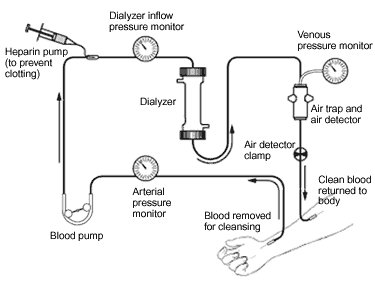
|
- Kidney Transplant
- Over 38,000 people wait for a kidney transplant each year, yet less than 12,000 people
actually receive an organ.
- On average, transplanted kidneys last about 30 years.
- Patients still have to take powerful anti-rejection drugs, because their bodies recognize foreign cells and try to destroy them. -Dialysis -process in which machines are used to purify the blood of those who suffer from kidney failure - acts as an artificial kidney -2 different kinds: 1.) Hemodialysis -performed in a clinic, usually three or more times a week - a shunt is inserted into patient's arm - each treatment lasts five to six hours 2.) Peritoneal dialysis - can be done at home, five times a day - a shunt is inserted into patient's abdomen - each treatment lasts about one hour - machine used is usually eight feet tall, weighs 100 pounds
-Current Experiments
-These transplants are more vigorously rejected
- Using pig organs in humans is dangerous - pig organs may contain diseases that are dangerous to humans
-Skin Grafts
- Scientists are able to implant the patient's own cells in a matrix that allows them to grow.
- The patient's body will not usually reject the new skin, because it recognizes its cells as self. |
|
Kidneys are a vital part of the human body. Most people are born
with two kidneys, which are bean-shaped organs located at the back of the body, around waist level. Each kidney consists of approximately one million nephrons, which are the functioning units of the kidney. A kidney's job is to remove waste products and excess water from the body in the form of urine. Kidneys also balance salt and acid levels and produce certain hormones. When a patient suffers from kidney failure, they have only two options for treatment. These are kidney transplant and dialysis, which are outlined below. |



|
Image of Hemodialysis
|
|
Image of Peritoneal Dialysis
|
|
Image of Peritoneal Dialysis
|


|
A Lesson in Human Stem Cells
What are human stem cells?
- They are undifferentiated cells that will develop into specialized cells (nerve cells, bone cells, etc.)
- They are being investigated to see how cells differentiate(develop & change)
Where do stem cells come from?
- They are found in the embryo, fetal tissue, and adult tissue (bone marrow) - Embryo and fetal tissue can differentiate into any type of cell. - Adult stem cells can develop into the tissue that they come from, but they can also differentiate into other types of cells under certain conditions.
Why is stem cell research controversial?
- Stem cells from animals and accepted human sources (placenta, fetal tissue, etc.) have been used for many years for experimenting. - The controversy surrounds human embryos, because they must be destroyed for the stem cells to be used. |
|
Adult stem cells derived from
bone marrow. |